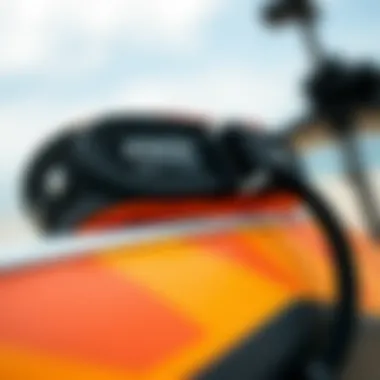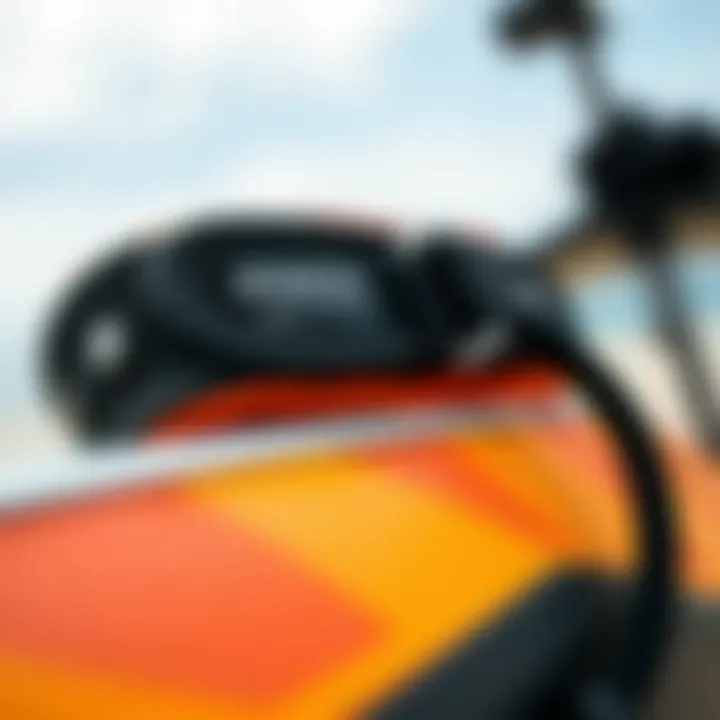Understanding the Sup Waist Leash for Kiteboarding


Intro
Kiteboarding is a thrilling sport, blending surfing, wind power, and an aerial dance that captivates enthusiasts around the globe. Amidst all the excitement, safety and control are of paramount importance, particularly when using various equipment. One such piece of equipment that arguably deserves more spotlight is the sup waist leash. This accessory might seem modest, but it plays a crucial role in enhancing the kiteboarding experience by ensuring that riders remain securely connected to their boards while navigating wind and waves.
In this guide, we will explore the ins and outs of the sup waist leash. Whether you’re a novice looking to solidify your foundation or a seasoned kiteboarder aiming to refine your technique, understanding this accessory is essential. This article dives into its design, functionality, and benefits, laying out tips and tricks for optimal use. Through a deep dive into safety, versatility, and maintenance of the sup waist leash, we aim to equip kiteboarding enthusiasts with valuable insights to elevate their riding sessions.
Equipment Insights
An array of choices awaits when it comes to gear, and understanding what you need can make or break your experience on the water. The sup waist leash stands out not just for its practicality but also for its innovative design that caters to a wide range of riders.
Latest Gear Reviews
When shopping for a sup waist leash, it's wise to consider factors such as length, material, and ease of use. The best leashes are often made from high-durability materials that resist wear and tear, especially under intense conditions. The following are popular options among kiteboarders today:
- ION Sup Waist Leash: Known for its robust construction and comfort fit, this model features a quick-release mechanism for immediate detachment during emergencies.
- Dakine Sup Leash: This model has a solid reputation for its versatility and reliability—ideal for those who enjoy a mix of freestyle and wave riding.
Safety note: Always look for leashes with reinforced stitching to prevent catastrophic failure during high-adrenaline maneuvers.
Essential Gear Maintenance
Maintaining your sup waist leash ensures longevity and reliability. Here are tips to keep it in prime condition:
- Rinse off salt water and sand after each session to prevent corrosion.
- Inspect for frays or wear regularly, particularly after intense use.
- Store it in a cool, dry place away from direct sunlight, which can degrade materials over time.
Technique Exploration
Mastering the art of kiteboarding often hinges on understanding the dynamics of your equipment. The sup waist leash affects not just safety but also how you manage your movements on the water.
Beginner Techniques
For those just dipping their toes into kiteboarding, humbling your expectations and adopting a stable stance is vital. Use the sup waist leash effectively by applying the following techniques:
- Practice Balance: Start by riding straight and feeling the leash engage and release. This helps to intuitively understand your connection with the board.
- Controlled Falls: If you fall, activate the quick-release on the leash immediately. This practice ensures that you become comfortable with emergency situations.
Advanced Maneuvers
Advanced riders can further leverage the sup waist leash to execute more complicated tricks and maneuvers. Consider these pointers:
- Switch Stance Tricks: The leash provides the versatility needed to switch stances mid-ride, allowing for a variety of tricks.
- Spins and Rotations: Engage the leash to maintain board control during aerial spins. This connection is key for getting back in line after a landing.
"The key to mastering kiteboarding lies in how well you adapt your techniques to the support of your gear. The sup waist leash is more than just a safety tool; it’s a component of your riding style."
As kiteboarding continues to grow and evolve, understanding and utilizing the sup waist leash correctly not only enhances safety but also enriches your overall experience on the water. Staying updated with gear and techniques is paramount for all riders, regardless of skill level.
For further in-depth discussions on kiteboarding equipment, consider visiting forums like reddit.com or communities on Facebook. These platforms are treasure troves of shared knowledge and personal experiences.
Stay tuned for the next sections that will delve deeper into technique refinement and advanced kiteboarding methods.
Prolusion to the Sup Waist Leash
In the exhilarating realm of kiteboarding, where the sky meets the sea, having the right gear is crucial for both performance and safety. One accessory that plays a pivotal role is the sup waist leash. The sup waist leash is not just a piece of equipment; it has become an essential tool that enhances the riding experience for many enthusiasts. Understanding its features and purpose can significantly improve one's time on the water.
Definition and Purpose
At its core, a sup waist leash is designed to secure the board to the rider's body via the waist, allowing for a more flexible and mobile experience. Unlike standard leashes traditionally used in kiteboarding, which connect directly to the board, the sup waist leash minimizes tangles and offers ease of movement. This ergonomic design allows riders to navigate tricky waves and execute maneuvers without the leash hindering their mobility.
Moreover, the sup waist leash serves as a crucial safety feature. In unexpected situations, like sudden falls or strong gusts of wind, this leash ensures the board stays nearby, preventing it from drifting away. It acts almost like a lifeline, providing peace of mind while tackling the elements. By keeping riders connected to their gear, it reduces the risk of losing equipment, which can be especially vital in rough conditions.
Evolution of Leashes in Kiteboarding
The journey of leashes in the kiteboarding world is a tale of continuous innovation and adaptation. In the early days, kiteboarders relied heavily on simple, straight-line leashes that often led to tangled lines and board separation during aggressive riding. Over time, as the sport evolved, so did the technology surrounding leashes.
Sup waist leashes emerged as a response to the demands of modern kiteboarding. They combine functionality with style, adapting to the needs of riders who seek more freedom. Riders wanted a leash that did not impede their movements, especially during tricks, and manufacturers answered the call. The materials used in these leashes have also seen significant advancements, focusing on durability and resilience, often incorporating neoprene or other water-resistant fabrics to withstand harsh conditions.
This evolution marks a shift towards optimizing performance while prioritizing safety. In today’s kiteboarding scene, sup waist leashes are a testament to how gear can enhance both skill and enjoyment on the water.
By understanding the significance of the sup waist leash, kiteboarders can make informed choices that can elevate their riding experience to new heights.
Design Features of Sup Waist Leashes
In kiteboarding, where every piece of equipment can significantly affect performance, understanding the design features of a sup waist leash becomes crucial. This accessory is not just a connector between the rider and the board; it plays a vital role in enhancing mobility, safety, and comfort during the ride. Let's break down these features to grasp the impact they have on the kiteboarding experience.
Material Composition
The materials used to construct a sup waist leash are not just there for decoration; they serve critical functions. High-quality leashes are generally made of durable and lightweight materials like nylon or polyester, which provide enough strength to withstand the forces encountered during kiteboarding. The leash should be resistant to wear and tear from saltwater, UV exposure, and normal usage.
- Nylon: Known for its elasticity and strength, nylon ensures that the leash can stretch slightly, absorbing shocks without snapping.
- Polyester: Offers lower stretch and can maintain its shape better under pressure, making it a good option for riders who prefer more control.


It's essential to remember that not all materials are created equal; those made from rip-proof fabrics will ensure longevity even after multiple sessions.
Adjustability and Comfort
A leash that fits well is as important as the kite or board. If it’s too tight, you might feel restricted; if it’s too loose, it can create a nuisance. Many sup waist leashes come with adjustable straps and quick-release systems, allowing users to tailor the fit according to their comfort level.
- Quick-release buckles: Make it easy to detach the leash during emergencies, which is vital when unpredictable conditions arise.
- Padding options: Some leashes come with added padding to provide comfort around the waist. This feature significantly enhances the user's experience, especially during long riding sessions.
Comfort in design can mean fewer distractions, allowing the rider to focus on their performance and not on adjustments.
Connection Mechanisms
The way the leash connects to the board and the rider is another aspect where design shines. A sup waist leash typically uses a specific connection system that facilitates easy attachment and detachment while maintaining a secure bond during use.
- Loop and hook: This method allows for a strong connection but is also easy enough to manage after a wipeout.
- D-ring attachments: Popular among advanced kiteboarders, these can be adjusted for various riding styles.
- Swivels: Reduces the chance of tangling, especially important when spinning or jumping.
Every detail in the connection mechanisms not only influences safety but also impacts performance, shaping how the rider interacts with the board and the kite.
The combination of these design features makes the sup waist leash not just a functional tool but an integral part of the kiteboarding experience. It ensures that the rider can maintain mobility and security on the water, adapting to various conditions while keeping comfort at the forefront.
Functional Advantages of Sup Waist Leashes
In the dynamic world of kiteboarding, the often-overlooked details can make all the difference. The sup waist leash, in particular, stands out for its functional advantages, presenting kiteboarders with various benefits that enhance their overall riding experience. Understanding these advantages not only improves performance on the water but also boosts safety and adaptability during sessions.
Enhanced Mobility
One of the primary strengths of the sup waist leash is its enhanced mobility. Unlike traditional leashes tethered to the ankle or foot, this design allows for a greater range of motion. This freedom becomes crucial when maneuvering through waves or executing complex tricks. A kiteboarder’s agility can be the deciding factor in riding smoothly or crashing. Here’s why this mobility matters:
- Unrestricted Movement: With the leash at the waist, the rider can turn, twist, and dive without being held back by a traditional ankle leash. This positioning helps riders maintain balance and control, especially in challenging conditions.
- Improved Weight Distribution: The placement of the waist leash means there's less weight pulling on the rider's legs. This balance shifts the center of gravity, allowing for better performance during jumps and turns.
In practice, this means kiteboarders can ride with a more fluid style, improving their overall experience on the water.
Safety Considerations
When it comes to kiteboarding, safety can never be overstated. The functional design of the sup waist leash contributes to enhanced safety measures. Here are key considerations:
- Quick Release Mechanism: One of the standout features of many sup waist leashes is the quick-release mechanism. In emergency situations, this feature allows for rapid detachment from the board, minimizing the risk of accidents.
- Less Chance of Snags: With the leash secured around the waist, there’s a reduced risk of the leash getting tangled in the board or other equipment. This lowers the chance of wipeouts due to unexpected entanglements, giving riders peace of mind even in chaotic conditions.
"Investing in a waist leash is not merely about performance; it's about making every session safer."
These safety benefits are paramount, especially for those who often find themselves in unpredictable environments.
Versatility in Various Conditions
Kiteboarding draws practitioners into diverse settings—sunny shores, gusty open waters, or stormy lakes. The sup waist leash shines in its versatility across various conditions, adapting to meet the needs of kiteboarders regardless of where they are riding. Consider these aspects:
- Adaptability to Weather: In changing weather conditions, a waist leash can be more effective. The way it’s designed allows for adjustments that help maintain performance even as wind and wave patterns shift.
- Functionality for All Skill Levels: Whether the rider is a beginner still learning the ropes or an expert tackling intense waves, the waist leash can suit different styles and skill levels. It brings confidence to newcomers while offering advanced features that seasoned riders appreciate.
This versatility is what makes the sup waist leash an invaluable tool in any kiteboarder's arsenal, providing efficient performance under varied conditions.
In summary, the functional advantages of sup waist leashes not only elevate the kiteboarding experience through improved mobility and safety but also adapt seamlessly to a myriad of riding conditions. Understanding these benefits positions riders to make informed choices, ultimately enhancing their time spent on the water.
Tips for Choosing the Right Sup Waist Leash
Selecting the right sup waist leash is more than just a matter of preference; it can significantly influence your experience on the water. With various features, styles, and types available, making an informed decision can enhance both comfort and performance while kiteboarding. Understanding your riding style, the environment in which you will be using the leash, and your personal preferences will guide you in finding the ideal leash. In the following sections, we'll break down these essential elements to consider when making your selection.
Assessing Riding Style
Riding style plays a pivotal role in choosing the appropriate sup waist leash. Are you a freestyle fanatic, or do you prefer carving through waves? Knowing how you ride will help inform your choice. For instance, a leash suitable for jumping and tricks may differ from one aimed at cruising on flat waters.
- Freestyle Riders: If you love performing aerial maneuvers, look for leashes designed with flexibility and added length. A longer leash allows for movement and reduces the chance of entanglement, ensuring that you stay dynamic in your performance.
- Wave Riders: Shorter, sturdier leashes might be more appropriate, as they minimize drag and keep your equipment close during those rolling waves.
- Freeriders: For those who enjoy blending styles, a balanced leash that offers sufficient length yet provides stability is crucial.
Understanding how often you engage in these different styles will also help you choose a leash that can perform well across various riding conditions. It’s also beneficial to connect with fellow kiteboarders for insight into which leashes they find best suit their styles.
Considering Environmental Factors
The elements greatly affect kiteboarding, and your leash is no exception. Assessing environmental factors should be at the forefront of your decision-making process. The conditions can vary widely—from calm lakes to choppy seas—and your choice of leash can impact your performance and safety.
- Water Conditions: In saltwater, a leash made from materials that resist corrosion is essential. Conversely, fresh water might permit more leeway in leash material.
- Wind Strength: For high-wind conditions, a leash that is durable and can withstand intense pressure is critical.
- Terrain and Obstacles: If your routes involve potential hazards like rocks or reefs, consider leashes with quick-release mechanisms. This increases safety as it allows for a quick detachment when needed.
Overall, choosing a leash that aligns with environmental challenges will further elevate your riding performance.
Evaluating Personal Preferences
Beyond the technical aspects, personal preference can’t be overlooked when choosing a sup waist leash. Each kiteboarder has unique tastes influenced by comfort, style, and specific riding requirements.
- Fit and Feel: It’s vital to find a leash that sits comfortably on your waist. Some riders prefer a tighter fit that stays secure, while others might want a more relaxed option. Trying on different leashes before purchasing can help find that perfect fit.
- Aesthetics: While performance is key, visual appeal comes into play too. There are various colors and designs available, so pick a leash that resonates with your style.
- Budget Considerations: Different price points exist, and budget may affect your choices. It is wise to balance quality with cost. Investing in a durable and reliable leash can save you from frequent replacements in the long run.
Prioritizing what matters most to you will help filter out options, leaving you with a leash that feels tailored to your personal riding experience.


Ultimately, the goal is to find a sup waist leash that enhances your kiteboarding journey by providing support, safety, and comfort while you're out conquering the waves.
Installation and Adjustments
When it comes to kiteboarding, every detail counts, and that includes the installation and adjustment of your sup waist leash. Getting this part right is pivotal—not just for your comfort but for your safety and performance on the water. A well-installed and properly adjusted leash can transform your ride, making it more enjoyable and secure. Not to forget, a little attention to this aspect can save you from potential headaches during your sessions.
Proper Attachment Techniques
Understanding how to correctly attach your sup waist leash is essential. First off, take a closer look at your leash itself. The leash often comes with a loop and velcro straps that need to bind perfectly to prevent any slip-ups. Start by threading your leash through the attachment point on your harness. Ensure that the loop is snug but not overly tight—too much pressure might hinder your movements, while too little might cause it to detach.
Don’t skip on ensuring the leash is aligned properly with your body. If the leash is twisted or misaligned, it could lead to complications while kiteboarding. Adjust the leash so it’s extending straight out from your body, reducing drag and allowing for fluid motion. Think of it like tying your shoelaces; you want it snug enough to stay put, but loose enough to let you move without resistance.
"A leash that's properly attached is a gateway to freedom on the water. Go with the flow, but stay secure."
Adjusting for Comfort and Security
Once you have the leash attached, the next step is fine-tuning it for comfort. A leash that isn’t adjusted correctly can rub against your skin or harness, leading to discomfort that will nag at you throughout your session. To adjust for comfort, check the tightness of the velcro straps around your waist; they should not constrict you. The ideal fit supports your movements without feeling restrictive.
Then, there’s the matter of security. When out on the water, the last thing you want is for your leash to loosen unexpectedly. Make sure the straps lock in place securely. You can check this by giving them a gentle tug after you’ve adjusted them—if they don’t budge, you’re golden. It’s about striking that balance; you want it secure enough to withstand the forces of kiteboarding, but not so tight it ruins your day.
Maintenance and Care
Maintaining your sup waist leash is a crucial element of kiteboarding that often gets overlooked. Keeping your gear in tip-top shape can significantly prolong its lifespan and enhance your riding experience. A well-maintained leash not only ensures safety but also offers peace of mind. When waves are talkin’ and the wind is howlin’, you don’t want to worry about whether your gear is up to snuff.
Cleaning Practices
The primary step in leash maintenance is proper cleaning. After every session, it’s a good habit to rinse your sup waist leash with fresh water. Saltwater and sand can be relentless adversaries, potentially leading to material degradation over time. A simple rinse ensures that crumbs from the ocean don’t stick around to cause damage. Here’s how to do it:
- Quick Rinse: As soon as you get off the water, give your leash a thorough rinse. Focus on the connection points and any areas that might trap debris.
- Gentle Scrub: For any stubborn stains or sand that just won’t budge, use a soft brush or cloth. Avoid abrasive materials that could scratch the leash.
- Drying: After a good rinse, lay your leash flat to dry in a shaded area. Don’t leave it hanging in direct sunlight, as UV rays can weaken the material over time.
Regular cleaning keeps your leash looking fresh and functioning properly. Think of it like putting gas in your car; if you don’t do it, you’ll end up stuck.
Storage Recommendations
It’s not just about how you use your leash but also how you store it. Proper storage helps in avoiding unnecessary wear and tear.
- Avoid Prolonged Sun Exposure: Store your leash in a cool, dry place, ideally away from direct sunlight. A shadowy storage space keeps the elastic and other materials intact.
- Roll It Up: It’s best to roll your leash instead of folding it. This prevents creases and kinks that might weaken it over time.
- Use a Bag: If you have a travel bag for your kiteboarding gear, toss the leash in there. Keeping it in a designated spot reduces the risk of tangling or getting damaged by other equipment.
- Regular Inspections: Every now and then, take a moment to inspect your leash for any signs of wear. Look for frayed edges or weak connection points. Catching signs early on can save you from potential accidents.
Taking time for maintenance and care not only enhances the lifespan of your sup waist leash but also keeps you safer while you're out riding those waves.
"Investing in your gear's durability pays off big time when the tide's rolling in and you're ready to ride!"
Incorporating these simple cleaning and storage practices into your routine can make a world of difference. By keeping your leash clean and properly stored, you’re ensuring that every session is as enjoyable as the last.
Comparative Analysis with Other Leash Types
A comparative analysis of various leash types relevant to kiteboarding can significantly optimize a rider's experience on the water. By contrasting the sup waist leash with traditional leash types, enthusiasts will gain a comprehensive understanding of how design and functionality impact performance and safety.
Traditional Leash vs. Sup Waist Leash
In the realm of kiteboarding, the traditional leash has long been the go-to option for many riders. This conventional design generally connects a rider to their kite through a wrist attachment. However, when we scrutinize the sup waist leash, it becomes clear that this adaptation offers distinct advantages.
The key differentiation lies in the attachment style; while a traditional leash can restrict movement and may even result in dangerous entanglements, the sup waist leash allows for greater freedom. A waist leash distributes the pull across the core instead of just the wrist, ultimately enhancing maneuverability. Riders looking to catch those wind-gliding moments without feeling shackled will appreciate this essential upgrade.
In terms of comfort, the sup waist leash typically features padded sections that sit against the rider's waist or harness, ensuring a snug fit. In contrast, traditional leashes are often less forgiving, which can lead to fatigue during longer sessions. Riders accustomed to cutting through waves or tackling jumps will find that this harness-style approach enables better posture and less strain.
Common Strengths and Limitations
Every leash type comes with its strengths and weaknesses, and the sup waist leash is no exception. The following bullet points highlight these aspects:
- Strengths of Sup Waist Leashes:
- Limitations of Sup Waist Leashes:
- Unparalleled mobility: Riders can maneuver more fluidly without the risk of being yanked down.
- Increased safety: If a wipeout occurs, the risk of being pulled under is significantly reduced.
- Comfortable fit: Many models incorporate ergonomic designs that minimize chafing and enhance overall comfort.
- Learning curve: Newcomers to kitesurfing might take time to adjust to the waist attachment, leading to initial awkwardness.
- Compatibility issues: Not all boards and kites are optimally designed for waist leashes, leading to potential mismatches.
Understanding both the strengths and limitations of sup waist leashes compared to traditional leashes empowers kiteboarders to make informed decisions, ultimately elevating their experience on the water. Furthermore, kiteboarding is about innovation, so acknowledging these differences can inspire riders to further explore their kit and tailor it to their unique style.
Influence of Leash Features on Kitesurfing Performance
The leash that connects a kiteboarder to their board plays a crucial role in their overall performance on the water. Understanding the influence of different leash features can provide riders with advantages tailored to their style and conditions. Each aspect of a sup waist leash can significantly affect not just convenience but also safety and skill execution. From how the leash materials respond to wave conditions, to its adaptability for different jumping styles, knowing these subtleties can help kiteboarders elevate their game.
Impact on Wave Riding
When it comes to riding waves, the leash you choose can make a world of difference. A well-constructed sup waist leash, for example, can easily handle the intense pull and pressure of ocean swell. The length of the leash can either promote or hinder your movement. A shorter leash, for instance, offers less drag, allowing for sharper turns and quicker responses to wave dynamics.
- Flexibility: A leash that has a degree of stretch can absorb shocks when you hit waves, reducing stress on your body.
- Attachment point: Higher attachment points can also contribute to creating a more streamlined movement, making it easier to navigate waves efficiently.


Many kiteboarders report that modern leashes, being designed for optimal performance, encourage deeper carving and increased speed. This ultimately leads to a more engaging wave riding experience where maneuverability and control are paramount.
"The right leash can completely change how you interact with the ocean. It's like having an extra limb that understands your moves."
Effects on Jumping and Freestyle Techniques
In the realm of jumping and freestyle, the leash acts almost like a trampoline effect, influencing how you launch into the air and how you land. A leash that is too long can create drag, which might throw off your timing for jumps, making it difficult to execute tricks successfully. Conversely, a leash that is appropriately sized can enable smooth takeoffs and landings.
Features to consider include:
- Thickness and Material: Behind every great jump, there's a sturdy yet lightweight leash. A heavier material can weigh you down, whereas a lightweight one allows for better aerial mobility.
- Attachment Mechanics: Secure attachment points can help prevent the leash from getting caught during complex tricks, enabling riders to focus solely on their technique.
Key Takeaways
Understanding the impact of leash features on overall performance is critical for kiteboarders looking to refine their skills. Whether it's navigating the intricacies of waves or perfecting freestyle moves, a well-thought-out leash design can make all the difference. As the sport evolves, staying informed about the latest leash technologies will be essential for enhancing one's riding experience.
Case Studies and Real-World Applications
When one delves into the intricacies of the sup waist leash, it becomes clear that theoretical discussions only scratch the surface. The real value lies in understanding how these leashes perform in authentic kiteboarding environments. Case studies and user experiences provide a fascinating lens through which to view these products in action, emphasizing not just their technical specifications but also their practical implications. This section aims to illuminate the various dimensions of sup waist leashes by examining expert feedback and personal stories from riders.
Expert Feedback on Usage
Experts in the kiteboarding realm, often seasoned veterans or instructors, see the sup waist leash as a critical element for both performance and safety. According to several prominent figures in the kiteboarding community, the design and material choices of these leashes directly influence how well the kiteboarder maintains control in challenging conditions.
One expert mentioned that the unique shape of the leash allows for more freedom of movement, providing an edge during high-intensity maneuvers. He emphasized how the leash's adjustment features can cater to a rider’s personal style, which is essential as different riders have varying preferences when it comes to comfort and security. In his own testing, he found that riding in choppy waters presented fewer challenges when using a well-designed sup waist leash compared to others, affirming that the right gear can significantly enhance one’s experience.
Moreover, expert feedback has placed a spotlight on safety. Many professionals advocate for leashes that quickly detach in emergency situations, highlighting cases where swift disconnection prevented injuries during unexpected wipeouts. This feedback is critical for new riders or those who may underestimate the importance of safety mechanisms.
User Experiences and Testimonials
The narratives from everyday kiteboarders offer a vivid tapestry of what the sup waist leash represents. User testimonials often reflect a myriad of experiences, from beginners getting their feet wet to advanced riders pushing the limits of their skills. A common thread in these testimonials is the balance of comfort and security—many riders noted how a well-fitted sup waist leash allows them to navigate waves and perform jumps without the nagging worry of losing their board.
- One rider from the shores of Florida shared that after switching to a sup waist leash, he felt liberated, stating, "It’s like dancing with the waves rather than wrestling them. My moves are more fluid, and the leash feels like it’s part of me."
- Another user from Hawaii noted the leash’s durability over time. She mentioned how previous leashes frayed much too quickly from exposure to saltwater. In contrast, her sup waist leash held up remarkably well, allowing her to focus purely on riding rather than worrying about equipment failure.
The diversity of feedback highlights not only the mechanical advantages of these leashes but also the emotional reactions that come with improved confidence while riding. With each positive experience shared, the notion that the right leash enhances a kiteboarder's journey—both physically and mentally—gains new strength.
It's through these case studies and real-world applications that we glean invaluable insights on the sup waist leash, transforming abstract designs into tangible results. Whether you’re pondering a purchase or simply seeking to understand this essential tool better, the collective experiences serve as a rich resource for navigating your kiteboarding adventures.
For those looking to dive deeper into the community and gather more perspectives, forums such as Reddit and kiteboarding blogs offer an abundance of personal stories and tips.
"The right gear not only amplifies performance; it shapes the very essence of your ride."
Engaging with these insights can empower you to make informed decisions about sup waist leashes, ensuring that every session on the water is as exhilarating as possible.
Future Trends in Sup Waist Leash Design
The kiteboarding industry is constantly evolving, and the design of the sup waist leash is no exception. As kiteboarders constantly seek improvements in safety, performance, and comfort, manufacturers are stepping up to the plate. Understanding the future trends in sup waist leash design not only keeps enthusiasts informed but also allows them to make educated decisions on the gear they choose. It’s more than just a leash; it’s a piece of technology designed to enhance the overall kiteboarding experience.
Innovative Materials and Technologies
As kiteboarding grows, so does the variety of materials used in the production of sup waist leashes. Recent innovations are focusing on lightweight yet durable components. For instance, materials like Dyneema—a high-strength synthetic fiber—are making waves for their strength-to-weight ratio. This would mean you can enjoy increased buoyancy without feeling weighed down.
New technologies, such as integrated shock-absorbing elements, are gaining popularity as they help in reducing the stress on the body during hard falls, keeping riders safer. Plus, the incorporation of reflective materials into leash designs can improve visibility during low-light conditions, ensuring that you're seen by others, adding an extra layer of safety.
"As technology advances, the leashes we use will not only keep us connected to our boards but also help prevent injuries that can diminish our experience on the water."
Anticipated Developments in Kiteboarding Gear
Furthermore, the kiteboarding landscape is not waiting around for progress. As kiteboarding gear becomes more sophisticated, the sup waist leash is evolving to match. Future models may incorporate smart technology, like built-in sensors that can monitor conditions, alerting riders to potential hazards or even gauging their performance metrics. This is particularly relevant when one considers the rise of data-driven training in sports.
We might also see designs offering modular features that allow kiteboarders to customize their harness systems based on personal preference or environmental conditions. For example, detachable components could let you switch from a standard leash to a coiled one without having to buy an entirely new setup.
The shift towards sustainability is also becoming vital. Expect manufacturers to look into eco-friendly materials that not only perform but also lessen environmental impact, appealing to the growing group of eco-conscious consumers. This development is already visible in other aspects of kite gear, and it’s safe to say that the sup waist leash will not be left behind.
By keeping an eye on these trends, kiteboarders can ensure their gear remains at the cutting edge, enhancing performance and safety on the water.
Ending
In summing up the integral role of the sup waist leash in kiteboarding, it becomes paramount to grasp its multifaceted nature. This accessory stands at the crossroads of safety and performance, embodying both characteristics that can significantly enhance a kiteboarder's riding experience. As discussed throughout this guide, the design features, such as material composition and adjustability, directly contribute to how divertly the leash responds under varying conditions. When considering practical advantages like enhanced mobility and versatility, kiteboarders are armed with crucial tools to tailor their gear to personal preferences and environmental challenges.
The importance of choosing the right sup waist leash can’t be overstated. With a proper fit and functionality, riders can engage with the waters more confidently, navigating waves or executing tricks without the fear of disconnection or entanglement. The influence of leash features on performance, as we explored, suggests that riders must continuously adapt and fine-tune their setup as their skills and conditions evolve.
As we take a step back, it’s worth noting that ongoing maintenance and proper care of the leash foster its longevity, paving a path for countless runs on the water. In an ever-advancing sport like kiteboarding, awareness of fresh trends will keep enthusiasts one step ahead, ensuring they remain at the forefront of kiteboarding developments.
Ultimately, the sup waist leash is not just a piece of equipment; it is a vital extension of the rider's own capabilities. Thus, an informed selection backed by insights can lead to enriched experiences and a deeper connection to the exhilarating essence of kiteboarding.
Recap of Key Insights
- The sup waist leash is designed to enhance safety and performance in kiteboarding.
- Key features include material composition, adjustability, and connection mechanisms that can impact mobility.
- Proper maintenance ensures a longer lifespan and better functionality of the leash.
- Knowledge of leash types allows for personalized experiences based on riding style and environmental conditions.
Encouragement for Further Exploration
As kiteboarding continues to evolve, practitioners are encouraged to stay curious and informed about advancements in gear and technology. Seek out forums, attend workshops, and engage with peers to gather diverse perspectives and insights. Websites like reddit.com/r/kitesurfing and kiteboarding.com can serve as valuable platforms for discussion and learning. Explore local kiteboarding communities to experience real-time feedback on different leash types and equipment.
Remember, the world of kiteboarding is vast and ever-changing. Remaining open to new techniques, gear innovations, and community wisdom can only serve to enhance your riding experience. Dive deeper into the details, enjoy the ride, and embrace the challenges that come your way in this thrilling sport.







